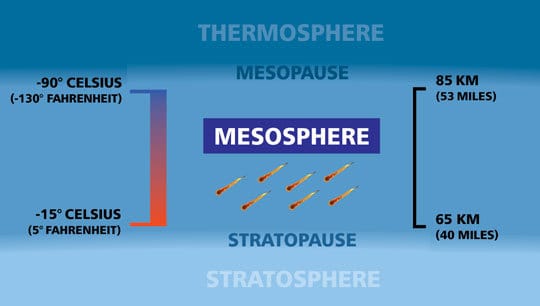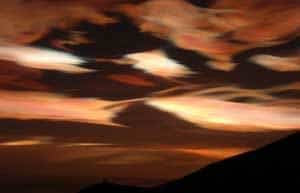Facts About The Stratosphere: What It Is And Its Defining Characteristics

Earth's atmosphere consists of five layers, each with its own features. The stratosphere is the second, situated above the troposphere. We examine this atmospheric layer and its defining characteristics.
The stratosphere is the second of Earth's five atmospheric layers, situated above the troposphere and below the mesosphere at an altitude of 10 km or 6 miles, extending to 50 km or 30 miles. It is the only layer where temperature inversion occurs and the region where the ozone layer is located.
It is easy & understandable to view our atmosphere as a continuous layer of air. However, it is made up out of five different layers: The troposphere, stratosphere, mesosphere, thermosphere, and exosphere. This article focus on the stratosphere, Earth's second layer.
It not only examines what the stratosphere is but also looks at the characteristics or facts that define it.
Stratosphere Definition

The stratosphere is situated just above the troposphere, with a thin layer of air called the tropopause separating the two layers. It reaches up to the mesosphere, with another thin layer of air called the stratopause separating them.
Like the other atmospheric layers, it does not have a fixed height but starts at an altitude of approximately 10 km (6 miles), extending up to a height of roughly 50 km (30 miles). It is also roughly 35 kilometers (22 miles) thick.
It is the only atmospheric layer where temperature inversion takes place. It means temperatures rise as altitude increases in this region, unlike the other four layers, which are characterized by a drop in temperature as altitude increases.
Close to the tropopause, temperatures start at approximately -51° Celsius (-60° Fahrenheit) and continue to rise until reaching the stratopause, where temperatures reach -15° Celsius (5° Fahrenheit).
The stratospheric air is extremely thin and dry since the vast majority of atmospheric gases (and weather activity) are limited to the troposphere. This is due to gravity, but mostly due to the temperature inversion in the tropopause that prevents gases from entering the layer.
As a result, the air in the stratosphere is about 1000 times thinner in the stratosphere than at sea level in the troposphere.

However, this feature allows commercial airliners to fly in the lower stratosphere while traveling faster and save fuel. The lack of particles in the air causes less friction to hold an aircraft back, which requires less power to travel faster and further.
(The lack of weather activity in the stratosphere also allows aircraft to avoid adverse weather conditions by flying in the lower stratosphere above the weather.)
Since almost almost weather activity is limited to the troposphere and almost no water vapor is present in the stratosphere, Polar Stratospheric Clouds is the only visual meteorological phenomenon that can be observed in the stratosphere.

Also known as Nacreous Clouds, these unique clouds develop near the poles at an altitude of 15 - 25 kilometers (9 - 15 miles) during the winter months. They are a combination of supercooled water and nitric acid that develop at very low temperatures.
(Learn more about Nacreous or Polar Stratospheric Clouds in this article.)
The stratosphere is home to the ozone layer, which is a thin layer of concentrated ozone which plays an essential role in protecting the Earth from dangerous solar radiation. It acts as a giant sponge and absorbs the vast majority of the sun's dangerous Ultraviolet Light.
(The ozone layer is too large a topic for this article, but you can read more about it in the following post.)
One of the most surprising things about the stratosphere is not its characteristics but about what you find in this layer. Certain bird species like the common crane, whooper swan, and the Rüppel's griffon vulture are capable of flying in the lower stratosphere.
Although it is situated above the upper reaches of conventional aircraft, scientists are still able to study it through the use of weather balloons, high-altitude aircraft, and also weather (sounding) rockets.
Air circulation within the stratosphere is dominated by the Brewer-Dobson Circulation, which is a single-celled air movement that stretches from the Poles to the Equator.
Facts About The Stratosphere
The following list highlights the characteristics and facts of the stratosphere in more detail.
- 1The stratosphere is the second layer of the atmosphere (above the troposphere.)
- 2It extends from a height of approximately 10 km (6 miles) to 50 km (30 miles) above the Earth's surface.
- 3It borders the troposphere below through a thin transitional space called the tropopause.
- 4It borders the mesosphere above through a thin transitional space called the stratopause.
- 5It is the only layer of the atmosphere where temperature inversion occurs (a drop in temperature as altitude increases.)
- 6The air in the stratosphere is about 1000 thinner than the air at sea level in the troposphere.
- 7The ozone layer is situated within this layer.
- 8Commercial airliners fly in the lower stratosphere to avoid the weather, travel faster, and save fuel.
- 9Polar Stratospheric Clouds develop in this layer near the poles at an altitude of 15 - 25 kilometers (9 - 15 miles) during the winter.
- 10Brewer-Dobson Circulation occurs in the stratosphere.
- 11The layer is approximately 35 kilometers (22 miles) thick.
- 12Certain swans, cranes, and vultures can fly in the lower stratosphere.
This list does not contain all the data available about the stratosphere but highlights the key facts and characteristics of this layer.
Conclusion
As this article clearly illustrated, the stratosphere has a crucial role to play in maintaining the atmosphere and all life in it.
It sets it apart from the other atmospheric layers by temperature rising instead of dropping as altitude increases, a process called temperature inversion.
The importance of the stratosphere is highlighted by the presence of the ozone layer, without which no life on Earth will be possible.
If you are interested in the complete structure and make-up of the atmosphere, this article covers all five atmospheric layers and their relation to each other in more detail.
Never miss out again when another interesting and helpful article is released and stay updated, while also receiving helpful tips & information by simply clicking on this link .
Until next time, keep your eye on the weather!

